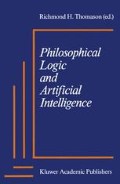Abstract
The use of circumscription for formalizing commonsense knowledge and reasoning requires that a circumscription policy be selected for each particular application: we should specify which predicates are circumscribed, which predicates and functions are allowed to vary, and what priorities between the circumscribed predicates are established. The circumscription policy is usually described either informally or using suitable metamathe-matical notation. In this paper we propose a simple and general formalism which permits describing circumscription policies by axioms, included in the knowledge base along with the axioms describing the objects of reasoning. The new formalism is illustrated by recasting some of the familiar applications of circumscription in its terms.
Access this chapter
Tax calculation will be finalised at checkout
Purchases are for personal use only
Preview
Unable to display preview. Download preview PDF.
Bibliography
Apt, K. R., H. A. Blair and A. Walker (1988) Towards the theory of declarative knowledge, in: J. Minker (ed.), Foundations of Deductive Databases and Logic Programming, Morgan Kaufmann Publishers, Los Altos, CA, pp. 89–148.
Henkin, L. (1950) Completeness in the theory of types, Journal of Symbolic Logic 15, pp. 81–91.
Hofstadter D. (1985) Metamagical Themas, Bantam Books.
Lifschitz, V. (1985) Computing circumscription, Proc. IJCAI-85 1, pp. 121–127.
Lifschitz, V. (1987) Pointwise circumscription, in M. Ginsberg (ed.), Readings in Nonmonotonic Reasoning, Morgan Kaufmann, Los Altos, pp. 179–193.
Lifschitz, V. (1987a) Circumscriptive theories: A logic-based framework for knowledge representation. Proc. AAAI-87 1 pp. 364–368.
Lifschitz, V. (1988) On the declarative semantics of logic programs with negation, in: J. Minker (ed.), Foundations of Deductive Databases and Logic Programming, Morgan Kaufmann Publishers, Los Altos, CA, pp. 177–192.
McCarthy, J. (1959) Programs with common sense, in Proceedings of the Teddington Conference on the Mechanization of Thought Processes, Her Majesty’s Stationery Office, London, pp. 75–84.
McCarthy, J. (1980) Circumscription—a form of nonmonotonic reasoning, Artificial Intelligence 13, pp. 27–39.
McCarthy, J. (1986) Applications of circumscription to formalizing commonsense knowledge, Artificial Intelligence 28, pp. 89–118.
Morris, K., J. D. Ullman and A. Van Gelder (1986) Design overview of the NAIL! system, in: G. Goos and J. Hartmanis (eds.), Third International Conference on Logic Programming (Lecture Notes in Computer Science 225), Springer-Verlag, pp. 554–568.
Perlis, D. (1987) Circumscribing with sets, Artificial Intelligence 31, pp. 201–211.
Touretzky, D.S. (1986) The Mathematics of Inheritance Systems, Research Notes in Artificial Intelligence, Pitman, London.
Van Gelder, A. (1988) Negation as failure using tight derivations for general logic programs, in: J. Minker (ed.), Foundations of Deductive Databases and Logic Programming, Morgan Kaufmann Publishers, Los Altos, CA, pp. 149–176.
Author information
Authors and Affiliations
Editor information
Editors and Affiliations
Rights and permissions
Copyright information
© 1989 Kluwer Academic Publishers
About this chapter
Cite this chapter
Lifschitz, V. (1989). Circumscriptive Theories: A Logic-Based Framework for Knowledge Representation. In: Thomason, R.H. (eds) Philosophical Logic and Artificial Intelligence. Springer, Dordrecht. https://doi.org/10.1007/978-94-009-2448-2_5
Download citation
DOI: https://doi.org/10.1007/978-94-009-2448-2_5
Publisher Name: Springer, Dordrecht
Print ISBN: 978-94-010-7604-3
Online ISBN: 978-94-009-2448-2
eBook Packages: Springer Book Archive

